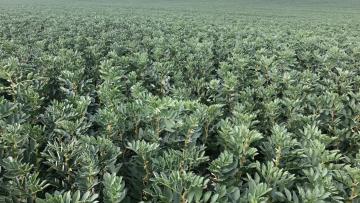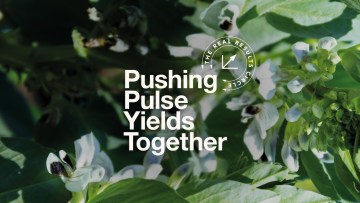July 2021 Pulse Check
28.07.2021

This month’s Pulse Check features Tony Nugent, agronomist and arable manager in Fethard, County Tipperary.
The land Tony manages is part of the Coolmore estate, an operation best known as world leaders in the bloodstock industry. Coolmore has bases in America and Australia, as well as in Ireland where they predominantly grow grass for the horses. The company also has around 5,000 acres in cereal production.
Why do you grow winter beans?
“They fit well in the rotation. We grow winter barley, winter wheat, oats and OSR here. The oats are kept for the horses, the rest is sold off the combine. I wanted to space the oilseed rape out and was looking for another break crop. Beans were a good fit and we’ve now got 250 hectares of the crop.
“Extending the time between the oilseed rape is just good agricultural practice – it reduces the sclerotinia risk and the build-up of cabbage stem flea beetle.
“Beans are a super crop that don’t need any nitrogen and they leave around 30 units for the following wheat crop. We’re late drilling our wheat here and it is quite nice going into drier ground following the beans. Bean roots branch well and that makes cultivations ahead of the wheat crop easier – one pass and we’ve a lovely seedbed.
“I also wanted to grow something the market wants and the feed mills want a native source of protein. It’ll never replace all the soya and maize that’s coming into Ireland but it can make a contribution.”
How do you protect the crop from weeds, pests and diseases?
“This year the beans have had 4.5l/ha of Nirvana pre-emergence. That was to tackle the broadleaved weeds – chickweed, fumitory, speedwell, redshank, mayweed and charlock. This was followed up post-emergence with Stratos Ultra (cycloxydim) for the wild oats, volunteer cereals and any bromes coming in from the headlands.
“For disease control, we’re on our second year with Signum. Last year, I went early. There wasn’t much disease about beforehand and there certainly wasn’t any after. The season was generally quite dry, with no big rain until August. Being dry, it was probably more of a year for rust but still there was nothing on our beans.
“This year has been very different. We had a cool May with plenty of rain, followed by some warm spells in June. The chocolate spot pressure has been quite high but still, there’s been no sign of disease.
“We’re quite particular about applications, though. You don’t want to be chasing disease so as we’re approaching early to mid-flower we get our fungicide on. It’s about getting in there early and protecting the leaf.
“The second application goes on 4-6 weeks later. I tend to like lower water volumes rates but go on with 200l/ha with Signum; in comparison with the other crops it’s a small area and I like to ensure we get the good coverage on all the leaves. We keep forward speeds down at around 12-14km/hr, depending on nozzle choice but usually 04 or 05 low-drift nozzles. We can probably go a little faster with the 05 nozzles but really try to keep speeds down to get that coverage.
“We tend to invest in crops. Having spent money on seed and herbicides, it would be madness to let chocolate spot and rust run riot in the crop!”
How is the crop looking now?
“It’s super! From disease control point of view, it’s spotless. Before the wet weather this weekend the leaves were just starting to curl – it shows how sensitive the crop can be. But with over an inch of rain, they are back to being relaxed and I’m hopeful for harvest.
“When beans are stressed they tend to be quite short and pods set closer to the ground, which makes harvest that little bit harder. This year our bean crop is quite a tall crop and pods have set well.”
“We average 5t/ha and I think we’re on track for that again this year.”

